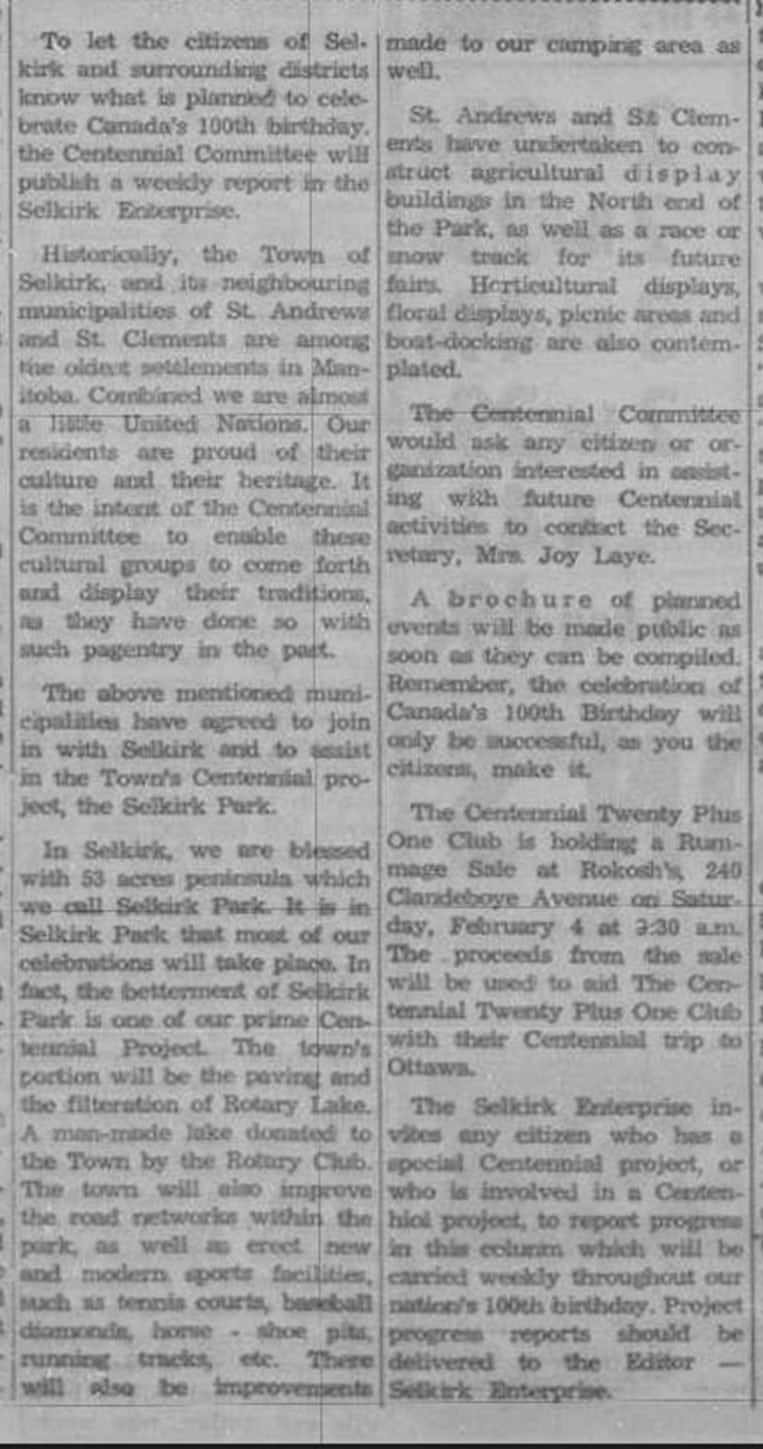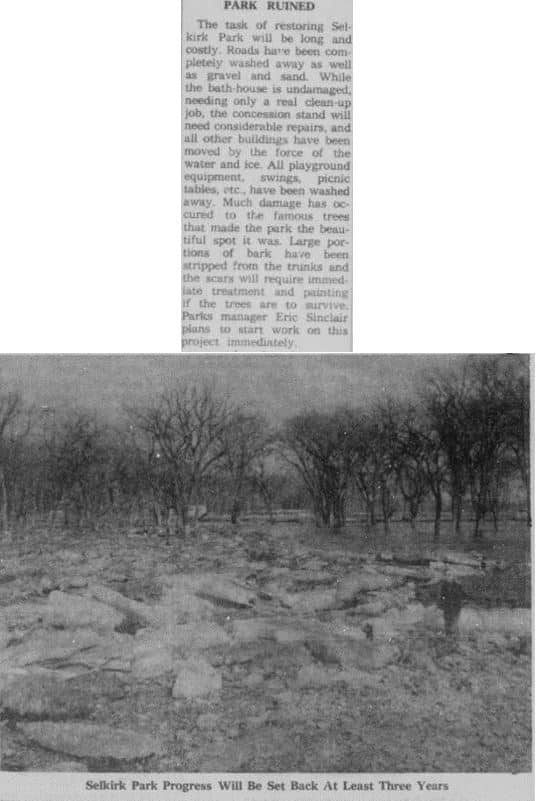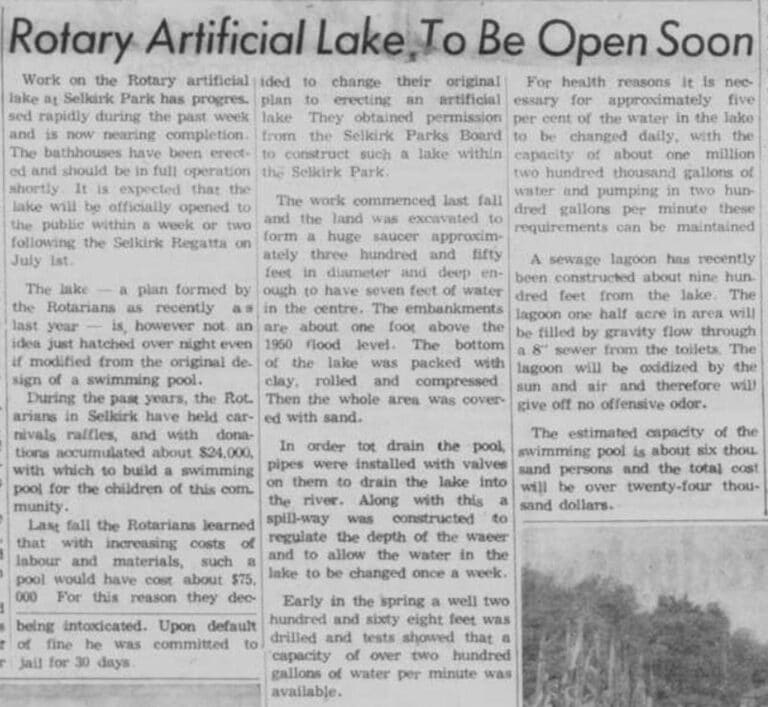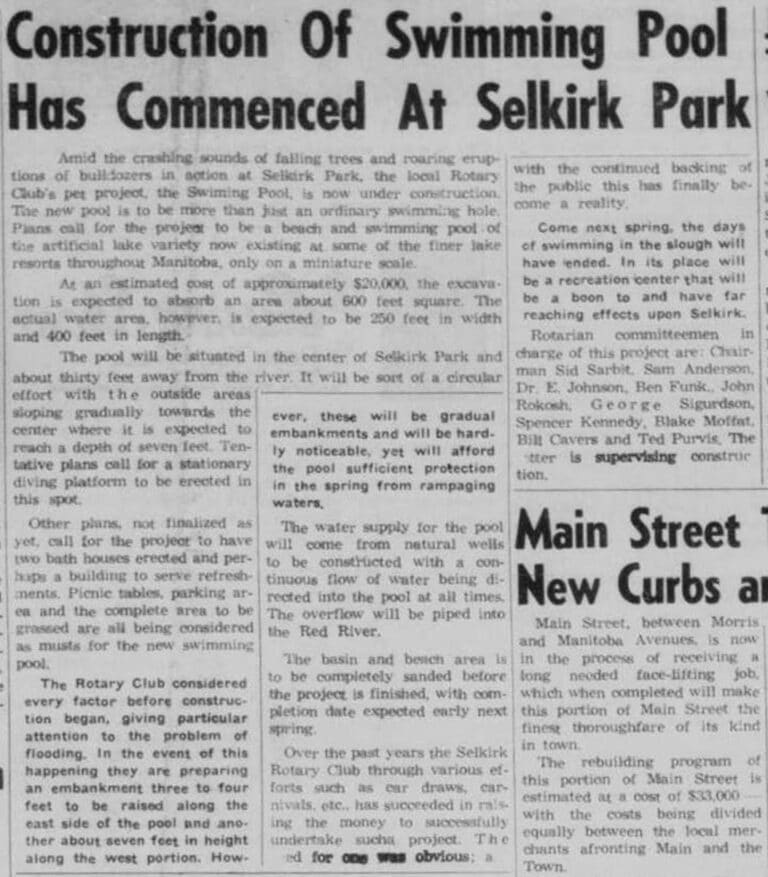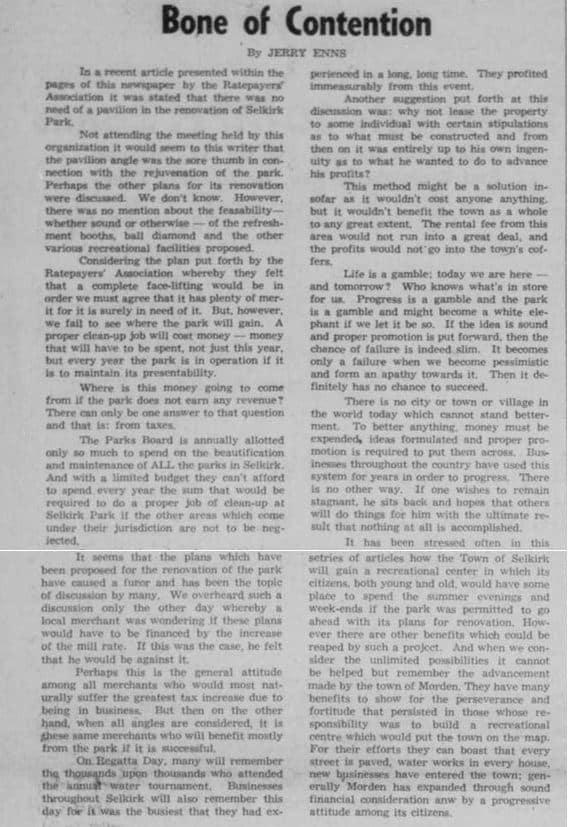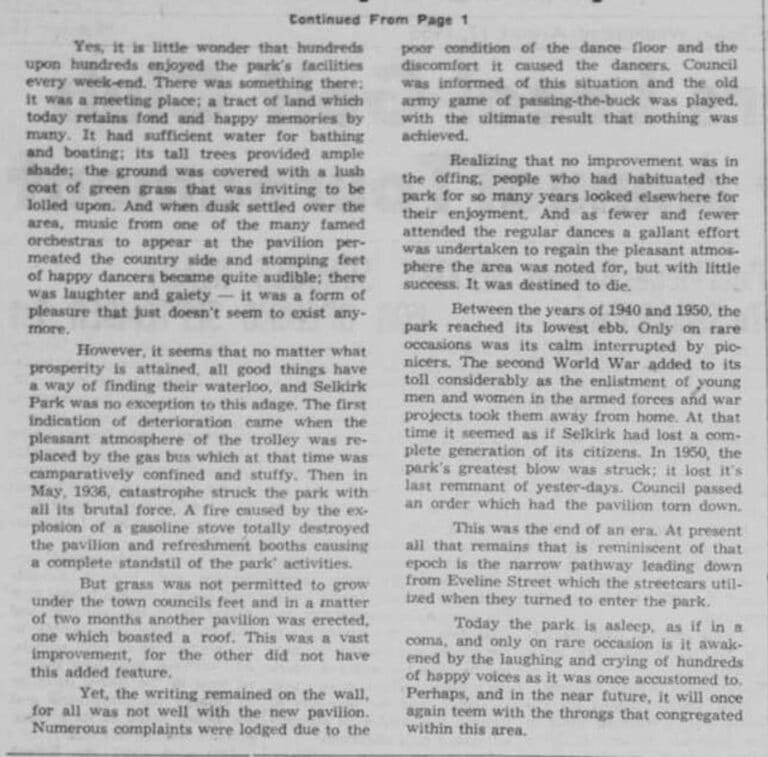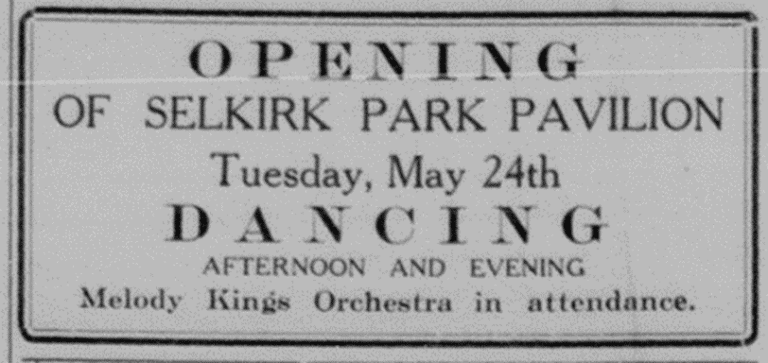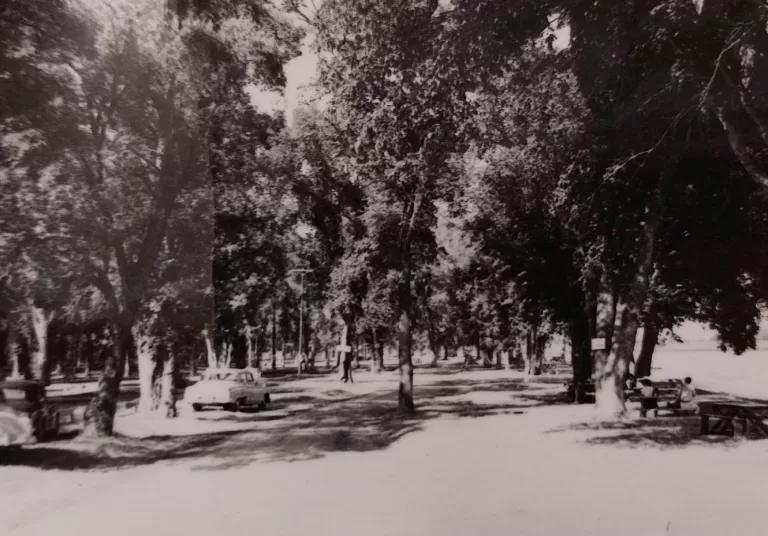486 Eveline St
On the morning of July 1, 1905, 1,200 members of the International Order of Oddfellows left Winnipeg for Selkirk aboard steam trains operated by the Winnipeg Selkirk and Lake Winnipeg Railway (WS & LW). They were greeted by Selkirk’s Oddfellows before walking a couple of kilometres to what was formerly Red River Park to participate in the opening day and enjoy picnics, sports and dances.

The 22-acre town-owned park (purchased from a private landowner just a couple of years before) was still very much in its natural state. The Winnipeg Free Press noted that “It is an ideal spot for picnics when all the improvements contemplated are completed,” and predicted that “Selkirk’s new park will no doubt become a popular resort during the summer months for excursions and picnics from the city.”.
The prediction was correct as over the next 30 years, it grew into one of the most popular spots for large summer outings such as staff picnics, children’s excursions, and for Winnipeg organizations looking for a quick and inexpensive getaway.
The key to the park’s success was due to the Canadian Pacific Railway that paved the way for WS & LW. WS & LW began freight and passenger service by steam engine from Winnipeg to Selkirk on August 26, 1904.
Train service for the first couple of years was ran and operated under WS & LW. The service consisted of one passenger train leaving Winnipeg in the morning and one returning in the evening. A cargo train to serve the warehouses and fish plants along Eveline Street ran three times a week. Weekend charter trains serviced picnickers.
In 1906, the Winnipeg Electric Railway Company (WERCo) bought out the railway but continued to operate it under run it under the WS & LW name. The new owners replaced the track and electrified the system so that the noisy and polluting steam engines could give way to urban streetcars. The changeover was completed in June 1908.
The updated service of three streetcars a day rather than one, brought more visitors than ever to Selkirk and Red River Park saw several improvements. The size of the lawn area was expanded, more furniture was added and in 1909, a pavilion was constructed to host dances and provide food service.
A Starlight Express service was also introduced in 1909 to make use of the pavilion. On Wednesdays and Saturdays, a series of streetcars packed with revellers and a dance orchestra left Winnipeg starting at 7:00 pm and returned from Selkirk starting at 10:15 pm.
Another improvement made to the rail service came in 1911 when a wye line was added off the mainline. The wye line was part of the Canadian Pacific Railway. The line went down from the north park entrance and made a loop in the park between where the boat launch and pool are now. This allowed riders to be picked up and dropped off from within the park.
The name change from Red River Park to Selkirk Park came around 1912.
Heyday 1912 - 1929
Through the 1910s and 20s, the park hosted numerous events that attracted hundreds of people at a time. This included gatherings of community service organizations like the Kinsmen or Oddfellows, large family reunions, boy scout camping trips, church outings, and company picnics for the Manitoba Rolling Mills and Hudson’s Bay Company. With the growing success came more improvements to the grounds and a new pavilion was added in 1923.
The park hosted what was believed to be its largest crowd to-date on the afternoon of August 26, 1926. Prime Minister Rt. Hon. Arthur Meighen came to speak during the 1926 federal election campaign. The speech took place as part of the local Conservative association’s annual picnic, but the town council declared the afternoon a holiday so that others could attend. One newspaper report estimated a crowd size of 2,000 people.
Decline 1930 - 1950
Selkirk Park’s boom years waned in the 1930s as people and companies alike faced the devastation of the Great Depression. As a free public park, it remained a popular place to visit, but the number of large-scale excursions became fewer as the years wore on.
In 1936, the pavilion burned to the ground and the town was not in a financial position to rebuild it. With passenger traffic to Selkirk down with little sign of it picking up anytime soon, the WERCo replaced the streetcar service with a bus service the following year.
Before the town could financially recover from the Great Depression, the Second World War began. This further delayed the redevelopment of Selkirk Park as large, joyous events fell out of style and many of the young men who would have attended the events were on active service.
After the war, cities and towns began reinvesting in their parks and recreation facilities to meet the demand of reunited couples and new families. Selkirk Park received renewed attention after years of neglect.
In January 1949, town councillor Cliff Morrison urged his colleagues to turn its focus to redeveloping Selkirk Park which he referred to as “a disgrace to Selkirk”. Another champion of the park was the Selkirk Enterprise which got behind his campaign and reminded readers: “This park was once one of the finest sites in Manitoba, crowded with busy picnickers and thriving with activity.”
Morrison persuaded the council to approve a series of basic improvements to the park site and to begin planning for its long-term rejuvenation. He also convinced them to lease out the operations of the park and a small concession stand to a third party. George Woods was awarded the five-year park contract and became its manager.
Selkirk Park opened for the season on Monday, May 24, 1949 with great promise. Woods carried out a number of improvements, such as; clearing away tons of debris; recreating lawns out of overgrown fields; and making repairs to buildings, furniture, and the footbridge.
The Selkirk Enterprise declared late in the season that: “Selkirk Park has once again become a focal point for recreation and it is playing host to visitors from outside our district….We are pleased with all the progress which has been made, and which is now being made. The entire town welcomes this new era.”.
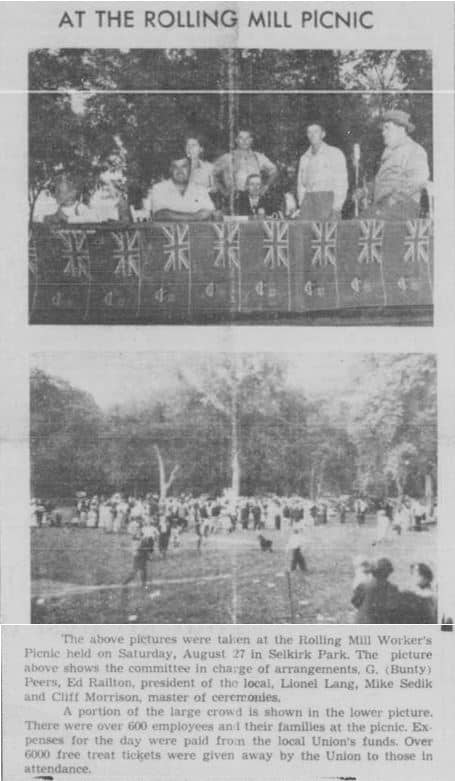
Sadly, the improvements were wiped out when the 1950 Red River Flood swamped the park and much of southern Manitoba. The grounds were again covered in debris and its buildings and park furniture swept away.
Rejuvenation 1953 - 1967
In 1953, Cliff Morrison, still a councillor and a member of the town’s recently created parks board, turned his attention again to Selkirk Park. He convinced the Manitoba Rolling Mills to donate 200 hours of labour towards park improvements. This included heavy work like recreating the gravel roadway and clearing debris, as well as building picnic tables, barbecue pits, swing sets, and sandboxes. A small concession stand was also set up.
Morrison brought councillors and the parks board members on a tour of the Selkirk Park late in the season to show off the improvements. He hoped to convince them that the park was worthy of more expensive investments that could be cost-shared with other levels of government, such as riverbank stabilization and diking, as well as large amenities such as the town swimming pool, which was still in the planning stages.
In 1954, the inaugural Selkirk Regatta took place and Selkirk Park was the focal point (the entire watercourse for races and other performances could be seen from it). The popularity of the event required several improvements to the park, such as expanded lawn areas, more park furniture, washrooms, a larger concession stand, and even a public address system. Most importantly, it introduced a new generation of residents to large-scale events in the park.
Selkirk’s 75th anniversary was marked in 1957 and thoughts turned to legacy projects.
The descendants of Dr. David Young, a former director of the Selkirk Mental Hospital, donated the remainder of the peninsula that Selkirk Park was on to the town in June 1957 for the purpose of a public park. This brought the park’s total acreage to 100.
Next came the Rotary Club, which had been raising funds for a town pool for several years. Town council and the Rotary Club agreed that Selkirk Park would be the perfect spot for the $20,000 facility. Plans were redrawn so that rather than a traditional concrete pool, it would be a 76-metre by 122-metre (250 ft x 400 ft) man-made lake with a beach.
Construction on Rotary Lake began in October 1957 and it opened to the public on July 14, 1958.

In the spring of 1960, ice jams and flooding once again caused extensive damage to the park. At Rotary Lake, the main bathhouse was spared but the concession stand and other buildings were destroyed, causing $10,000 worth of damage. Most of the park’s furniture and playground equipment was washed away.
It took a couple of years to repair the damage, with numerous companies and service organizations making donations of time, money and equipment. Sadly, Clifford Morrison would not be around to see the park restored. He died in the fall of 1960.
In the mid-1960s, Selkirk Park was once again the center of attention.
The centennial celebrations of both Canada and Manitoba were to take place in 1967 and 1970, respectively. This meant that there was a great deal of money available from senior levels of governments for the construction of legacy projects.
Each municipality in the province was asked to submit at least one project for funding. The Town of Selkirk and the Rural Municipalities of St. Clements and St. Andrews formed a single Centennial Projects Committee and submitted a joint bid to make extensive improvements to Selkirk Park.
The town concentrated on major upgrades to the lake, such as a new filtration system and concreting its bottom and deck areas to create a more traditional style pool. It also wanted to start the first phase of construction of a new camping area for trailers, as well as a small marina.
The rural municipalities concentrated their efforts on a new fairground that consisted of a display building, livestock building and a show/rodeo ring.
The cost-sharing agreements for the projects were approved in 1965, and construction took place over the next two years. Everything was officially opened on July 1, 1967.
While the centennial improvements did not mark the end of Selkirk Park’s development, they laid the foundation for the amenities that can be found there today.
Selkirk Park Collection
Sources
George Barrowclough ca. 1906
Selkirk Enterprise 1908, 1911, 1949, 1953, 1955, 1957, 1958, 1960, 1961, 1965, 1966, 1967, 1968
Selkirk Journal 1955
Selkirk Record 1907, 1926, 1927
Selkirk the First Hundred Years, Barry Potyondi
The Voice 1913, 1916
Winnipeg Free Press 1904, 1905, 1918
Winnipeg Tribune 1904, 1905, 1909, 1910, 1911, 1913, 1917, 1926, 1938, 1949










